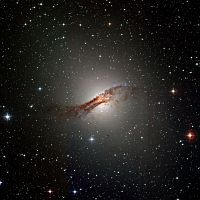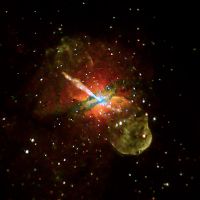Science Rationale
 Optical image of Centaurus A taken with the MPG/ESO 2.2-m telescope. (Credit: ESO)
Optical image of Centaurus A taken with the MPG/ESO 2.2-m telescope. (Credit: ESO)
Centaurus A (NGC 5128) is a spectacular giant radio galaxy. It is by far the closest galaxy in the Universe with an active, supermassive black hole, and it was the first extragalactic radio source to be identified (by CSIRO radiophysics astronomers Bolton, Stanley and Slee using cliff-top interferometry at Dover Heights). Centaurus A is seen in all electromagnetic wavebands from γ-ray, X-ray, ultraviolet, optical, infrared and radio and may well be the first identified extragalactic source of cosmic rays. It has emission from stars, neutral, molecular and ionised gas, relativistic plasma and a central supermassive black hole with an accretion disk and radio and X-ray jets triggering star formation far beyond the nucleus.
Centaurus A is well known for its dramatic belt of absorption crossing the centre of a bright giant elliptical galaxy. It has multiple dynamic systems and is the archetypal merging galaxy system. Centaurus A is one of the most well-studied galaxies in the Universe, but, somewhat remarkably, there has never been a conference focussing specifically on this quintessential southern galaxy.
 X-ray image of Centaurus A taken with Chandra. (Credit: NASA / CXC / CfA / R. Kraft et al.)
X-ray image of Centaurus A taken with Chandra. (Credit: NASA / CXC / CfA / R. Kraft et al.)
In recent years, we have seen a wealth of detail from powerful telescopes operating across the electromagnetic spectrum. This provides the unique opportunity to combine data from many wavebands and on different spatial scales with theory to advance our knowledge of galaxy formation, dynamics and active black hole evolution.
Up to four of the 27 highest energy cosmic ray events detected by the Pierre Auger Observatory (in their 1 January 2004 to 31 August 2007 dataset) arrive within 3° of Centaurus A. Centaurus A was detected in high-energy γ-rays by EGRET, and the Fermi Gamma-ray Space Telescope, launched in June 2008, will enable more sensitive, more regular, and higher angular resolution studies to be made.
The conference aims at bringing together a broad range of astronomers and high-energy physicists that traditionally form separate research communities. The radio galaxy Centaurus A has attracted great interest from the international astrophysics and high energy physics communities since its discovery as a radio source 60 years ago, and, to date, no other conference has been organised on this topic.